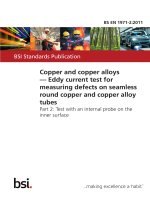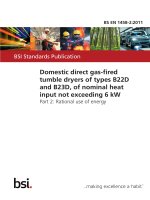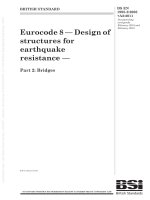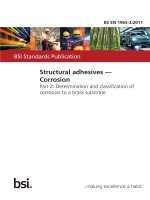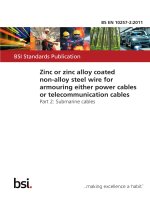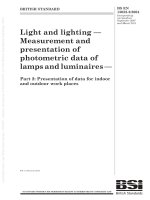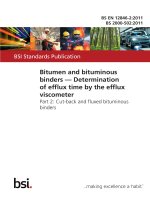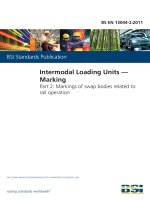Bsi bs en 62132 2 2011
Bạn đang xem bản rút gọn của tài liệu. Xem và tải ngay bản đầy đủ của tài liệu tại đây (1.19 MB, 28 trang )
BS EN 62132-2:2011
BSI Standards Publication
Integrated circuits —
Measurement of
electromagnetic immunity
Part 2: Measurement of radiated immunity —
TEM cell and wideband TEM cell method
BRITISH STANDARD
BS EN 62132-2:2011
National foreword
This British Standard is the UK implementation of EN 62132-2:2011. It is
identical to IEC 62132-2:2010.
The UK participation in its preparation was entrusted to Technical Committee
EPL/47, Semiconductors.
A list of organizations represented on this committee can be obtained on
request to its secretary.
This publication does not purport to include all the necessary provisions of a
contract. Users are responsible for its correct application.
© BSI 2011
ISBN 978 0 580 57114 5
ICS 31.200
Compliance with a British Standard cannot confer immunity from
legal obligations.
This British Standard was published under the authority of the Standards
Policy and Strategy Committee on 30 April 2011.
Amendments issued since publication
Amd. No.
Date
Text affected
BS EN 62132-2:2011
EUROPEAN STANDARD
EN 62132-2
NORME EUROPÉENNE
March 2011
EUROPÄISCHE NORM
ICS 31.200
English version
Integrated circuits Measurement of electromagnetic immunity Part 2: Measurement of radiated immunity TEM cell and wideband TEM cell method
(IEC 62132-2:2010)
Circuits intégrés Mesure de l'immunité électromagnétique Partie 2: Mesure de l'immunité rayonnée Méthode de cellule TEM et cellule TEM à
large bande
(CEI 62132-2:2010)
Integrierte Schaltungen Messung der elektromagnetischen
Störfestigkeit Teil 2: Messung der Störfestigkeit bei
Einstrahlungen TEM-Zellen- und Breitband-TEMZellenverfahren
(IEC 62132-2:2010)
This European Standard was approved by CENELEC on 2011-01-02. CENELEC members are bound to comply
with the CEN/CENELEC Internal Regulations which stipulate the conditions for giving this European Standard
the status of a national standard without any alteration.
Up-to-date lists and bibliographical references concerning such national standards may be obtained on
application to the Central Secretariat or to any CENELEC member.
This European Standard exists in three official versions (English, French, German). A version in any other
language made by translation under the responsibility of a CENELEC member into its own language and notified
to the Central Secretariat has the same status as the official versions.
CENELEC members are the national electrotechnical committees of Austria, Belgium, Bulgaria, Croatia, Cyprus,
the Czech Republic, Denmark, Estonia, Finland, France, Germany, Greece, Hungary, Iceland, Ireland, Italy,
Latvia, Lithuania, Luxembourg, Malta, the Netherlands, Norway, Poland, Portugal, Romania, Slovakia, Slovenia,
Spain, Sweden, Switzerland and the United Kingdom.
CENELEC
European Committee for Electrotechnical Standardization
Comité Européen de Normalisation Electrotechnique
Europäisches Komitee für Elektrotechnische Normung
Management Centre: Avenue Marnix 17, B - 1000 Brussels
© 2011 CENELEC -
All rights of exploitation in any form and by any means reserved worldwide for CENELEC members.
Ref. No. EN 62132-2:2011 E
BS EN 62132-2:2011
EN 62132-2:2011
-2-
Foreword
The text of document 47A/838/FDIS, future edition 1 of IEC 62132-2, prepared by SC 47A, Integrated
circuits, of IEC TC 47, Semiconductor devices, was submitted to the IEC-CENELEC parallel vote and was
approved by CENELEC as EN 62132-2 on 2011-01-02.
This part of EN 62132 is to be read in conjunction with EN 62132-1.
Attention is drawn to the possibility that some of the elements of this document may be the subject of
patent rights. CEN and CENELEC shall not be held responsible for identifying any or all such patent
rights.
The following dates were fixed:
– latest date by which the EN has to be implemented
at national level by publication of an identical
national standard or by endorsement
(dop)
2011-10-02
– latest date by which the national standards conflicting
with the EN have to be withdrawn
(dow)
2014-01-02
Annex ZA has been added by CENELEC.
__________
Endorsement notice
The text of the International Standard IEC 62132-2:2010 was approved by CENELEC as a European
Standard without any modification.
In the official version, for Bibliography, the following notes have to be added for the standards indicated:
[7] IEC 61000-4-3:2006
IEC 61000-4-3:2006/A1:2007
NOTE Harmonized as EN 61000-4-3:2006 (not modified).
NOTE Harmonized as EN 61000-4-3:2006/A1:2008 (not modified).
[8] IEC 61000-4-6:2008
NOTE Harmonized as EN 61000-4-6:2009 (not modified).
[9] IEC 61000-4-20:2003
NOTE Harmonized as EN 61000-4-20:2003 (not modified).
[10] CISPR 16-1-1:2006
NOTE Harmonized as EN 55016-1-1:2007 (not modified).
[12] CISPR 16-1-5:2003
NOTE Harmonized as EN 55016-1-5:2004 (not modified).
[13] CISPR 16-2-1:2008
NOTE Harmonized as EN 55016-2-1:2009 (not modified).
[15] CISPR 16-2-3:2006
NOTE Harmonized as EN 55016-2-3:2006 (not modified).
[16] CISPR 16-2-4:2003
NOTE Harmonized as EN 55016-2-4:2004 (not modified).
__________
BS EN 62132-2:2011
EN 62132-2:2011
-3-
Annex ZA
(normative)
Normative references to international publications
with their corresponding European publications
The following referenced documents are indispensable for the application of this document. For dated
references, only the edition cited applies. For undated references, the latest edition of the referenced
document (including any amendments) applies.
NOTE When an international publication has been modified by common modifications, indicated by (mod), the relevant EN/HD
applies.
Publication
Year
Title
EN/HD
Year
IEC 60050-131
2002
International Electrotechnical Vocabulary
(IEV) Part 131: Circuit theory
-
-
IEC 60050-161
1990
International Electrotechnical Vocabulary
(IEV) Chapter 161: Electromagnetic compatibility
-
-
IEC 61967-2
-
EN 61967-2
Integrated circuits - Measurement of
electromagnetic emissions,
150 kHz to 1 GHz Part 2: Measurement of radiated emissions TEM cell and wideband TEM cell method
-
IEC 62132-1
2006
Integrated circuits - Measurement of
electromagnetic immunity,
150 kHz to 1 GHz Part 1: General conditions and definitions
2006
2006
EN 62132-1
+ corr. November
BS EN 62132-2:2011
–2–
62132-2 © IEC:2010
CONTENTS
1
Scope ...............................................................................................................................................5
2
Normative references ....................................................................................................................5
3
Terms and definitions ....................................................................................................................5
4
General . ..........................................................................................................................................6
5
Test conditions . ..............................................................................................................................7
6
Test equipment. ..............................................................................................................................7
6.1
6.2
6.3
6.4
6.5
General . ................................................................................................................................7
Cables. ..................................................................................................................................7
RF disturbance source . ......................................................................................................7
TEM cell . ...............................................................................................................................8
Gigahertz TEM cell . .............................................................................................................8
7
6.6 50-Ω termination . ................................................................................................................8
6.7 DUT monitor . ........................................................................................................................8
Test set-up ......................................................................................................................................8
8
7.1
7.2
7.3
Test
General . ................................................................................................................................8
Test set-up details . ..............................................................................................................8
EMC test board . ................................................................................................................10
procedure .............................................................................................................................10
8.1
8.2
9
General . ..............................................................................................................................10
Immunity measurement . ...................................................................................................10
8.2.1 General . ................................................................................................................10
8.2.2 RF disturbance signals . ......................................................................................10
8.2.3 Test frequencies . ..................................................................................................11
8.2.4 Test levels and dwell time . .................................................................................11
8.2.5 DUT monitoring . ...................................................................................................11
8.2.6 Detail procedure . ..................................................................................................11
Test report.....................................................................................................................................12
Annex A (normative) Field strength characterization procedure................................................. 13
Annex B (informative) TEM CELL and wideband TEM cell descriptions . .................................. 21
Bibliography. ........................................................................................................................................22
Figure 1 – TEM and GTEM cell cross-section . .................................................................................9
Figure 2 – TEM cell test set-up ...........................................................................................................9
Figure 3 – GTEM cell test set-up. .....................................................................................................10
Figure 4 – Immunity measurement procedure flowchart ...............................................................12
Figure A.1 – E-field characterization test fixture . ...........................................................................14
Figure A.2 – The electric field to voltage transfer function . .......................................................... 16
Figure A.3 – H-field characterization test fixture. ...........................................................................19
Figure A.4 – The magnetic field to voltage transfer function . ...................................................... 20
BS EN 62132-2:2011
62132-2 © IEC:2010
–5–
INTEGRATED CIRCUITS – MEASUREMENT OF
ELECTROMAGNETIC IMMUNITY –
Part 2: Measurement of radiated immunity –
TEM cell and wideband TEM cell method
1
Scope
This International Standard specifies a method for measuring the immunity of an integrated
circuit (IC) to radio frequency (RF) radiated electromagnetic disturbances. The frequency
range of this method is from 150 kHz to 1 GHz, or as limited by the characteristics of the TEM
cell.
2
Normative references
The following referenced documents are indispensable for the application of this document.
For dated references, only the edition cited applies. For undated references, the latest edition
of the referenced document (including any amendments) applies.
IEC 60050-131:2002, International Electrotechnical Vocabulary (IEV) – Part 131: Circuit
theory
IEC 60050-161:1990, International
Electromagnetic compatibility
Electrotechnical
Vocabulary
(IEV)
–
Chapter
161:
IEC 61967-2, Integrated circuits – Measurement of electromagnetic emissions, 150 kHz to
1 GHz – Part 2: Measurement of radiated emissions – TEM cell and wideband TEM cell
method
IEC 62132-1:2006, Integrated circuits – Measurement of electromagnetic immunity, 150 kHz
to 1 GHz – Part 1: General conditions and definitions
3
Terms and definitions
For the purpose of this document, the definitions in IEC 62132-1, IEC 60050-131 and
IEC 60050-161, as well as the following, apply.
3.1
transverse electromagnetic mode (TEM)
waveguide mode in which the components of the electric and magnetic fields in the
propagation direction are much less than the primary field components across any transverse
cross-section
3.2
TEM waveguide
open or closed transmission line system, in which a wave is propagating in the transverse
electromagnetic mode to produce a specified field for testing purposes.
BS EN 62132-2:2011
–6–
62132-2 © IEC:2010
3.3
TEM cell
enclosed TEM waveguide, often a rectangular coaxial line, in which a wave is propagated in
the transverse electromagnetic mode to produce a specified field for testing purposes. The
outer conductor completely encloses the inner conductor
3.4
two-port TEM waveguide
TEM waveguide with input/output measurement ports at both ends
3.5
one-port TEM waveguide
TEM waveguide with a single input/output measurement port
NOTE
Such TEM waveguides typically feature a broadband line termination at the non-measurement-port end.
3.6
characteristic impedance
for any constant phase wave-front, the magnitude of the ratio of the voltage between the inner
conductor and the outer conductor to the current on either conductor
NOTE The characteristic impedance is independent of the voltage/current magnitudes and depends only on the
cross-sectional geometry of the transmission line. TEM waveguides are typically designed to have a 50 Ω
characteristic impedance. TEM waveguides with a 100 Ω characteristic impedance are often used for transient
testing.
3.7
anechoic material
material that exhibits the property of absorbing, or otherwise reducing, the level of
electromagnetic energy reflected from that material
3.8
broadband line termination
termination which combines a low-frequency discrete-component load, to match the
characteristic impedance of the TEM waveguides (typically 50 Ω), and a high-frequency
anechoic-material volume
3.9
primary (field) component
electric field component aligned with the intended test polarization
NOTE For example, in conventional two-port TEM cells, the septum is parallel to the horizontal floor, and the
primary mode electric field vector is vertical at the transverse centre of the TEM cell.
3.10
secondary (field) component
in a Cartesian coordinate system, either of the two electric field components orthogonal to the
primary field component and orthogonal to each other
4
General
The IC to be evaluated for EMC performance is referred to as the device under test (DUT).
The DUT shall be mounted on a printed circuit board (PCB), referred to as the EMC test board.
The EMC test board is provided with the appropriate measurement or monitoring points at
which the DUT response parameters can be measured.
The EMC test board is clamped to a mating port (referred to as a wall port) cut in the top or
bottom of a transverse electromagnetic mode (TEM) cell. Either a two-port TEM cell or a oneport TEM cell may be used. Within this standard, a two-port TEM cell is referred to as a TEM
cell while a one-port TEM cell is referred to as a wideband (Gigahertz) TEM, or GTEM, cell.
BS EN 62132-2:2011
62132-2 © IEC:2010
–7–
The test board is not positioned inside the cell, as in the conventional usage, but becomes a
part of the cell wall. This method is applicable to any TEM or GTEM cell modified to
incorporate the wall port; however, the measured response of the DUT will be affected by
many factors. The primary factor affecting the DUT’s response is the septum to EMC test
board (cell wall) spacing.
NOTE 1 This procedure was developed using a 1 GHz TEM cell with a septum to housing spacing of 45 mm and a
GTEM cell with a septum to housing spacing of 45 mm at the centre of the wall port.
The EMC test board controls the geometry and orientation of the DUT relative to the cell and
eliminates any connecting leads within the cell (these are on the backside of the board, which
is outside the cell). For the TEM cell, one of the 50 Ω ports is terminated with a 50 Ω load.
The other 50 Ω port for a TEM cell, or the single 50 Ω port for a GTEM cell, is connected to
the output of an RF disturbance generator. The injected CW disturbance signal exposes the
DUT to a plane wave electromagnetic field where the electric field component is determined
by the injected voltage and the distance between the DUT and the septum of the cell. The
relationship is given by
E = V/h
where
E is the field strength (V/m) within the cell;
V is the applied voltage (V) across the 50 Ω load; and
h is the height (m) between the septum and the centre of the IC package.
Rotating the EMC test board in the four possible orientations in the wall port of the TEM or
GTEM cell is required to determine the sensitivity of the DUT to induced magnetic fields.
Dependent upon the DUT, the response parameters of the DUT may vary (e.g. a change of
current consumption, deterioration in function performance, waveform jitter, etc.) The intent of
this test method is to provide a quantitative measure of the RF immunity of ICs for comparison
or other purposes.
NOTE 2 Additional information on the use and characterization of TEM cells for radiated immunity testing can be
found in IEC 61000-4-20.
5
Test conditions
The test conditions shall meet the requirements as described in IEC 62132-1.
6
6.1
Test equipment
General
The test equipment shall meet the requirements as described in IEC 62132-1. In addition, the
following test equipment requirements shall apply.
6.2
Cables
Double shielded or semi-rigid coaxial cable may be required depending on the local RF
ambient conditions.
6.3
RF disturbance source
The RF disturbance source may comprise an RF signal generator with a modulation function,
an RF power amplifier, and an optional variable attenuator. The gain (or attenuation) of the
RF disturbance generating equipment, without the TEM or GTEM cell, shall be known with a
tolerance of ±0,5 dB.
BS EN 62132-2:2011
–8–
6.4
62132-2 © IEC:2010
TEM cell
The TEM cell used for this test procedure is a two-port TEM waveguide and shall be fitted
with a wall port sized to mate with the EMC test board. The TEM cell shall not exhibit higher
order modes over the frequency range being measured. For this procedure, the recommended
TEM cell frequency range is 150 kHz to the frequency of the first resonance of the lowest
higher order mode (typically <2 GHz). The frequency range being evaluated shall be covered
using only a single cell.
The VSWR of the TEM cell over the frequency range being measured shall be less than 1,5.
However, due to the potential for error when calculating the applied E-field, a TEM cell with a
VSWR of less than 1,2 is preferred. A TEM cell with a VSWR less than 1,2 does not require
field strength characterization. A TEM cell with a VSWR larger than or equal to 1,2 but less
than 1,5 shall be characterized in accordance with the procedure in Annex A. The raw TEM
cell VSWR data (over the frequency range of the measurement) shall be included in the test
report. Measurement results obtained from a TEM cell with a VSWR of less than 1,2 will
prevail over data taken from a TEM cell with a higher VSWR.
6.5
Gigahertz TEM cell
The Gigahertz, or wideband, TEM (GTEM) cell used for this test procedure is a one-port TEM
waveguide and shall be fitted with a wall port sized to mate with the EMC test board. The
GTEM cell shall not exhibit higher order modes over the frequency range being measured. For
this procedure, the recommended GTEM cell frequency range is from 150 kHz to the
frequency of the first resonance of the lowest higher order mode (typically >2 GHz). The
frequency range being evaluated shall be covered using a single cell.
The VSWR of the GTEM cell over the frequency range being measured shall be less than 1,5.
However, due to the potential for error when calculating the applied E-field, a GTEM cell with
a VSWR of less than 1,2 is preferred. A GTEM cell with a VSWR less than 1,2 does not
require field strength characterization. A GTEM cell with a VSWR larger than or equal to 1,2
but less than 1,5 shall be characterized in accordance with the procedure in Annex A. The
raw GTEM cell VSWR data (over the frequency range of the measurement) shall be included
in the test report. Measurement results obtained from a GTEM cell with a VSWR of less than
1,2 will prevail over data taken from a GTEM cell with a higher VSWR.
6.6
50 Ω termination
A 50 Ω termination with a VSWR less than 1,1 and sufficient power handling capabilities over
the frequency range of measurement is required for the TEM cell measurement port not
connected to the RF disturbance generator.
6.7
DUT monitor
The performance of the DUT shall be monitored for indications of performance degradation.
The monitoring equipment shall not be adversely affected by the injected RF disturbance
signal.
7
7.1
Test set-up
General
The test set-up shall meet the requirements as described in IEC 62132-1. In addition, the
following test set-up requirements shall apply.
7.2
Test set-up details
The EMC test board shall be mounted in the wall port of the TEM cell or GTEM cell with the
DUT facing the septum as shown in Figure 1.
BS EN 62132-2:2011
62132-2 © IEC:2010
–9–
EMC test board
DUT
Cell septum
Cell housing
IEC
608/10
Figure 1 – TEM and GTEM cell cross-section
The test setup shall be as described in Figure 2 and Figure 3 for TEM cell and GTEM cell test
configurations, respectively. One of the TEM cell measurement ports shall be terminated with
a 50 Ω load. The remaining TEM cell measurement port, or the single GTEM measurement
port, shall be connected to the output port of the power amplifier.
RF disturbance source
Signal
generator
EMC test board
TEM cell
Attenuator
(optional)
Power
amplifier
50 Ω
termination
DUT monitor
IEC
Figure 2 – TEM cell test set-up
609/10
BS EN 62132-2:2011
62132-2 © IEC:2010
– 10 –
RF disturbance source
EMC test board
Signal
generator
Attenuator
(optional)
Power
amplifier
GTEM cell
DUT monitor
IEC
610/10
Figure 3 – GTEM cell test set-up
7.3
EMC test board
The EMC test board shall be designed in accordance with the requirements in IEC 61967-2.
8
Test procedure
8.1
General
The test procedure shall be in accordance with IEC 62132-1 except as modified herein. These
default test conditions are intended to assure a consistent test environment. The following
steps shall be performed:
a) field strength characterization (see Annex A);
b) immunity measurement (see 8.2).
If the users of this procedure agree to other conditions, these conditions shall be documented
in the test report.
8.2
Immunity measurement
8.2.1
General
With the EMC test board energized and the DUT being operated in the intended test mode,
measure the immunity to the injected RF disturbance signal over the desired frequency range.
8.2.2
RF disturbance signals
The RF disturbance signals shall be
•
CW (continuous wave) and
•
AM (amplitude modulated CW) at 80 % depth by a 1 kHz sine wave or (optionally) pulse
modulated at 100 % depth with 50 % duty cycle and 1 kHz pulse repetition rate.
BS EN 62132-2:2011
62132-2 © IEC:2010
– 11 –
NOTE The optional pulse modulation requirement is typically about 6 dB more severe than the stated amplitude
modulation requirement.
8.2.3
Test frequencies
The RF immunity of the DUT shall be evaluated at a number of discrete test frequencies from
150 kHz to 1 GHz, or as limited by the characteristics of the TEM cell. The frequencies to be
tested shall be generated from the requirements specified in Table 2 of IEC 62132-1.
In addition, the RF immunity of the DUT shall be evaluated at critical frequencies. Critical
frequencies are frequencies that are generated by, received by, or operated on by the DUT.
Critical frequencies include but are not limited to crystal frequencies, oscillator frequencies,
clock frequencies, data frequencies, etc.
8.2.4
Test levels and dwell time
The applied test level shall be increased in steps until a malfunction is observed or the
maximum signal generator setting is reached. The step size shall be documented in the test
report.
At each test level and frequency, the RF disturbance signal shall be applied for a minimum of
1 s (or at least the time necessary for the DUT to respond and the monitoring system to detect
any performance degradation).
8.2.5
DUT monitoring
The DUT shall be monitored for indications of susceptibility using the appropriate test
equipment and as required in IEC 62132-1.
8.2.6
8.2.6.1
Detail procedure
Field strength characterization
At each frequency to be tested, the signal generator setting to achieve the desired electric
field level or levels shall be determined as described in Annex A.
8.2.6.2
Immunity measurement
The test flow, including major steps, is described in Figure 4. One of two strategies may be
employed in performing this measurement as follows:
a) the output of the RF disturbance generator shall be set at a low value (e.g. 20 dB below
the desired limit) and slowly increased up to the desired limit while monitoring the DUT for
performance degradation. Any performance degradation at or below the desired limit shall
be recorded;
b) the output of the RF disturbance generator shall be set at the desired performance limit
while monitoring the DUT for performance degradation. Any performance degradation at
the desired limit shall be recorded. The output of the RF disturbance generator shall then
be reduced until normal function returns. The output of the RF disturbance generator shall
then be increased until the performance degradation occurs again. This level shall also be
recorded.
NOTE The DUT may respond differently to each of the above methods. In such a case, a method in which the
interference signal is ramped up as well as down may be required.
The RF immunity measurement shall be performed in each of the four possible orientations
resulting in four separate sets of data. The first measurement is made with the IC test board
mounted in an arbitrary orientation of the IC in the cell wall port. The second measurement is
made with the IC test board rotated 90 degrees from the orientation in the first measurement.
For each of the third and fourth measurements, the test board is rotated again to ensure
BS EN 62132-2:2011
62132-2 © IEC:2010
– 12 –
immunity is measured in all four possible orientations. The four sets of data shall be
documented in the test report.
9
Test report
The test report shall be in accordance with the requirements of IEC 62132-1.
Operational
check
C
Record
data
Set initial
test frequency
B
Set initial
output voltage
A
Final
output
level?
No
Increment
output voltage
A
No
Increment
frequency
B
No
Rotate board
90°
C
Yes
Enable RF output and
apply modulation
All
frequencies
done?
Immune?
No
Yes
Yes
No
All
polarities
done?
Dwell time
met?
Yes
PASS
Yes
FAIL
END
IEC 611/10
Figure 4 – Immunity measurement procedure flowchart
BS EN 62132-2:2011
62132-2 © IEC:2010
– 13 –
Annex A
(normative)
Field strength characterization procedure
A.1
General
The signal level setting of the RF disturbance generator required to achieve the desired
electric field level within the TEM or GTEM cell shall be determined in accordance with this
procedure. This measurement shall be performed at each standard frequency (either linear or
logarithmic as used in the actual test) as determined in accordance with 8.2.3. The RF
disturbance signal used for characterization shall be a CW signal (e.g. no modulation shall be
applied).
A.2
A.2.1
Electric (E) field strength characterization
Electric field characterization test fixture
The electric field can be measured by using a small monopole antenna at the centre location
of the characterization board as shown in Figure A.1. It is recommended that the diameter of
the top plate capacitive load shall be small (e.g. an area of approximately 0,001 m 2 or 10 cm 2 )
and either circular or square. The antenna top plate shall be kept parallel to the top metallic
surface of the characterization board, which may be either a printed circuit board or metal
plate, at a height of 3,0 mm ±0,1 mm. This top plate will yield a capacitance of about 3 pF.
The centre of this plate shall be fed to a surface-mount, coaxial bulkhead connector that in
turn shall be connected to the 50 Ω input impedance of an RF voltmeter or spectrum analyser.
The resulting high-pass circuit results in an incremental slope of 20 dB/decade over the full
frequency range up to 1 GHz.
The characterization board shall be identical in size to the EMC test board to be used during
the actual radiated immunity measurements as specified in IEC 62132-1. The bulkhead
connector shall be a 50 Ω type, either SMA or SMB, and placed in the exact centre of the
characterization board.
The PCB shall be constructed with at least one conductive layer. The conductive layer should
cover the entire board forming a solid ground plane. The SMA or SMB connector should be
mounted on the side of the PCB opposite the ground plane, with its outer conductor
connected to the ground plane and the centre conductor passing through an unplated,
through-hole penetration to the other side of the board. Additional conductive PCB layers
should be assigned to ground and connected using multiple vias as shown for the EMC test
board in IEC 62132-1.
NOTE
A.2.2
Tolerances for top plate area, capacitance and board location are under development.
Capacitance measurement
The top plate capacitance of the monopole shall be measured separately to assure a
capacitance of 3 pF. The capacitance shall be measured with the characterization test fixture
inserted into the TEM cell. With the impedance reference plane set at the bulkhead coaxial
connector mounted at the location where the device/IC is to be positioned, the monopole is
mounted to this bulkhead connector and the impedance (i.e. capacitance) is measured at a
reference frequency of 10 MHz. This measurement is made to ensure that the physical length
of the wire (i.e. the inductance) does not affect the characterization.
BS EN 62132-2:2011
62132-2 © IEC:2010
– 14 –
Capacitive top-load plate
2
area ~0,001 m
PCB or
metal plate
Monopole antenna
with top-load
3,0 mm ± 0,1 mm
Surface-mount, bulkhead
SMA or SMB connector
IEC
612/10
In the case of a PCB, a ground plane is required on both sides
Figure A.1 – E field characterization test fixture
A.2.3
Electric field strength calculation
The voltage induced at the output of the monopole antenna is given by
Vant = hant × E tem
(A.1)
where
V ant
is the voltage at the test fixture output port, expressed in volts (V), by the internal
electric field;
E tem is the electric field within the TEM or GTEM cell, expressed in volts per meter (V/m);
h ant
is the height of the monopole antenna, expressed in meters (m).
In addition, the electric field in the TEM or GTEM cell is also given by
E tem =
V tem
⇒ V tem = E tem × hsep
hsep
where
V tem is the voltage at the port of the TEM or GTEM cell, expressed in volts (V);
(A.2)
BS EN 62132-2:2011
62132-2 © IEC:2010
– 15 –
h sep is the distance from the antenna top load to the inner septum of the TEM or GTEM cell,
expressed in meters (m).
So that the resulting transfer function (S21) is given by
S21 =
Vant
h
= ant ×
V tem
hsep
50
(50) 2 + Z ant
(A.3)
2
where
|Z ant |
is the magnitude of the antenna impedance, given by |1/(jωC)| and expressed in ohms
(Ω), neglecting resistance.
The antenna impedance is given by
Z ant =
1
ωC ant_meas
=
1
(A.4)
2πf × C ant_meas
where
Cant_meas
A.2.4
is the measured antenna capacitance, expressed in farads (F).
Example electric field strength calculation
At 10 MHz, solving for V ant as a function of E tem using Equation (A.1) gives
(
)
Vant = 3 × 10 −3 × E tem
For a monopole antenna with a measured capacitance of 3 pF, the antenna impedance is
calculated from Equation (A.4):
Z ant,10MHz =
1
2π × (10 × 10 Hz ) × (3 × 10 −12 F)
6
= 5305
Ω
So the resulting transfer function at 10 MHz for h sep = 45 mm – 3 mm = 42 mm is calculated
using Equation (A.3) giving
S21 =
3 × 10 −3 m
42 × 10
−3
m
⋅
50
(50 ) 2 + (5305 ) 2
= 673,9 × 10 −6
Converting the S21 value to decibels gives the final result as
(
)
S21dB = 20 ⋅ log 673,9 × 10 −6 = −63,43 dB
The electric field to voltage transfer function given in Equation (A.3) and converted to decibels,
for the parameters given above, is plotted in Figure A.2 and is suited for characterization up
to 1 GHz. The value of the transfer function shall be compensated for the TEM cell septum-todevice height as given in A.4.
Due to the non-ideal nature of TEM cell and GTEM cell devices, a maximum deviation of 6 dB
is allowed for 3 % of the frequencies determined in accordance with 8.2.3. For all other
frequencies, the performance of the field strength shall be within 1 dB of the ideal curve given
BS EN 62132-2:2011
62132-2 © IEC:2010
– 16 –
in Figure A.2. Frequencies at which the deviation is greater than 1 dB shall be listed in the
test report.
NOTE Any failure at a frequency with a deviation of greater than 1 dB should be ignored during qualification
testing.
Monopole antenna S21
0,00
–10,00
–20,00
–30,00
S21 (dB)
–40,00
–50,00
–60,00
–70,00
–80,00
–90,00
–100,00
6
1 × 10
S21 (dB)
7
8
1 × 10
1 × 10
9
1 × 10
Frequency (Hz)
IEC 613/10
Figure A.2 – The electric field to voltage transfer function
When the characterization needs to be performed at higher frequencies (>1 GHz), the
parameters of the probe shall be adjusted such that the linear behavior is extended
accordingly (at the cost of sensitivity at the lower frequencies).
A.3
A.3.1
Magnetic (H) field strength characterization
Magnetic field strength characterization test fixture
The magnetic field can be measured by using a small loop antenna at the centre location of
the EMC test board as shown in Figure A.3. A magnetic loop shall be constructed using wire
with a 1 mm ±0,1 mm diameter. The loop shall have a separation height of 3,3 mm ±0,1 mm
from the top conductive surface of the test fixture. The length of the loop shall be 30 mm
±0,1 mm, which results in an effective loop area of approximately 99 mm 2 .
For the characterization, the loop shall be oriented in parallel to the propagation direction of
the EM wave in the TEM cell or GTEM cell.
The characterization board shall be identical in size to the EMC test board to be used during
the actual radiated immunity measurements as specified in IEC 62132-1. The bulkhead
connector shall be a 50 Ω type, either SMA or SMB. The bulkhead surface-mount, coaxial
connector shall be mounted 15 mm ±1,0 mm off-centre of the EMC test board.
The PCB shall be constructed with at least one conductive layer. The conductive layer should
cover the entire board forming a solid ground plane. The SMA or SMB connector should be
mounted on the side of the PCB opposite the ground plane, with its outer conductor
connected to the ground plane and the centre conductor passing through an unplated,
BS EN 62132-2:2011
62132-2 © IEC:2010
– 17 –
through-hole penetration to the other side of the board. Additional conductive PCB layers
should be assigned to ground and connected using multiple vias as shown for the EMC test
board in IEC 62132-1.
A.3.2
Magnetic field strength calculation
The voltage induced at the output of the loop antenna is given by
Vant = N ×
dΦ
dt
(A.5)
where
N=1
Φ (t ) = Φ × sin(ωt ) ⇒
dΦ
= Φ ×ω
dt
Φ = B × A loop
B = μo × H
H =
E
Zo
ω = 2πf
Substituting back into Equation (A.5) gives
⎛E
Vant = ⎜⎜ tem
⎝ Zo
⎞
⎟ × μ o × A loop × 2πf
⎟
⎠
(A.6)
where
V ant
is the voltage at the test fixture output port, expressed in volts (V), by the internal
electric field;
E tem
is the electric field within the TEM or GTEM cell, expressed in volts per meter (V/m);
Zo
is the characteristic impedance of free space (120 π Ω or 377 Ω );
µo
is the permeability of free space (4 π × 10 –7 H/m);
A loop
is the area of the loop antenna, expressed in square meters (m 2 );
f
is the frequency of interest, expressed in Hertz (Hz).
In addition, the electric field in the TEM or GTEM cell is also given by
E tem =
V tem
⇒ V tem = E tem × hsep
hsep
where
V tem
is the voltage at the port of the TEM or GTEM cell, expressed in volts (V);
(A.7)
BS EN 62132-2:2011
62132-2 © IEC:2010
– 18 –
is the distance from the antenna to the inner septum of the TEM or GTEM cell,
expressed in meters (m).
h sep
So that the resulting transfer function (S21) is given by
S21 =
μ o × A loop × 2πf
Vant
=
×
Vtem
Z o × hsep
50
2
(50 ) + ( Z ant )
(A.8)
2
where
|Z ant |
is the magnitude of the antenna impedance, given by | jωL | and expressed in ohms
( Ω ), neglecting resistance.
The antenna impedance is given by
Z ant = ϖLant_meas = 2πf × Lant_meas
(A.9)
where
is the measured inductance of the small loop antenna, expressed in henrys [H].
L ant_meas
A.3.3
Example magnetic field strength calculation
For the specified loop antenna, the loop area is
(
)(
)
A loop = h loop × l loop = 3,3 × 10 −3 m × 30 × 10 −3 m = 99 × 10 −6 m
2
where
h loop
is the height of the loop over the PCB, expressed in meters (m).
l loop
is the length of the loop, expressed in meters (m).
At 10 MHz, solving for V ant as a function of E tem using Equation (A.6) gives
(
)(
)(
)
(
⎛E
⎞
Vant = ⎜⎜ tem ⎟⎟ × 4π × 10 −7 × 99 × 10 −6 m 2 × 2π × 10 × 10 6 Hz = E tem × 20,1 × 10 −6
377
⎝
⎠
)
For a loop antenna with a measured inductance of 73 nH, the impedance is calculated using
Equation (A.9) giving
(
)(
)
Z ant,10MHz = 2π × 10 × 10 6 Hz ⋅ 73 × 10 −9 H = 4,58 Ω
So the resulting transfer function (S21) at 10 MHz for h sep = 45 mm – 3,3 mm = 41,7 mm is
calculated using Equation (A.8) giving
S21 =
(4π × 10 )× (99 × 10
−7
−6
) (
)
m 2 × 2π × 10 × 10 6 Hz
50
⋅
= 495,1 × 10 −6
−3
2
2
377 × 41,7 ⋅ 10 m
(50) + (4,58)
Converting the S21 value to decibels gives the final result as
(
)
S21dB = 20 ⋅ log 495,15 × 10 −6 = −66,11 dB
BS EN 62132-2:2011
62132-2 © IEC:2010
– 19 –
The magnetic field to voltage transfer function given in Equation (A.8) and converted to
decibels, for the parameters given above, is plotted in Figure A.4 and is suited for
characterization up to 1 GHz. The value of the transfer function shall be compensated for the
TEM cell septum-to-device height as given in A.4.
Due to the non-ideal nature of TEM cell and GTEM cell devices, a maximum deviation of 6 dB
is allowed for 3 % of the frequencies determined in accordance with 8.2.3. For all other
frequencies, the performance of the field strength shall be within 1 dB of the ideal curve given
in Figure A.4. Frequencies at which the deviation is greater than 1 dB shall be listed in the
test report.
NOTE 1
testing.
Any failure at a frequency with a deviation of greater than 1 dB should be ignored during qualification
NOTE 2 Since the magnetic field to voltage transfer function is not continuously proportional with frequency for
the parameters given above, the electric field to voltage characterization given in A.2 is preferred.
Loop antenna
30 mm
PCB or
metal plate
Loop antenna
3,3 mm
Surface-mount, bulkhead
SMA or SMB connector
In the case of a PCB, a ground plane is required on both sides
Figure A.3 – H field characterization test fixture
IEC
614/10
BS EN 62132-2:2011
62132-2 © IEC:2010
– 20 –
Loop antenna S21
0,00
–10,00
–20,00
–30,00
S21 (dB)
–40,00
–50,00
–60,00
–70,00
–80,00
–90,00
–100,00
6
1 × 10
7
8
1 × 10
S21 (dB)
1 × 10
9
1 × 10
Frequency (Hz)
IEC 615/10
Figure A.4 – The magnetic field to voltage transfer function
A.4
Package height correction
With the above calculations, it is assumed the field strength is homogeneous over the area of
integration. However, when a device/IC is packaged with the leadframe or heat spreader
grounded to the test board reference plane, a small correction shall be applied for the field
strength due to the change of height between septum and the “grounded” metal in the
package. For a septum to device height greater than the standard 45 mm, this correction can
be ignored. When the septum to device height is less than 45 mm, the local field strength is
significantly affected and shall be corrected.
Example:
Septum height = 30 mm
Diepad height = 1,5 mm
E-field correction = Septum height / (Septum height – diepad height) = 105 % ≈ 0,5 dB
A.5
Characterization set-up
The test set-up for characterization is similar to Figure 1 and Figure 2 except that the EMC
test board and the DUT monitor are replaced by the characterization board and a
measurement device. The SMA or SMB connector of the characterization board is connected
via a 50 Ω coaxial cable to the 50 Ω input of a measurement device such as an RF spectrum
analyzer, RF voltmeter or power meter. Alternately, a vector network analyzer may be used to
perform the characterization by providing both the stimulus (RF disturbance source) and
measurement in a single device.
A.6
Characterization procedure
For each frequency of interest, subtract the value of the measured signal from the value of the
injected signal and compare to the theoretical value given by the appropriate S21 equation.
All values shall be in decibels.
BS EN 62132-2:2011
62132-2 © IEC:2010
– 21 –
Annex B
(informative)
TEM CELL and wideband TEM cell descriptions
B.1
TEM cell
The TEM cell offers a broadband method of measuring either immunity of a DUT to fields
generated within the cell or radiated emissions from a DUT placed within the cell. It eliminates
the use of conventional antennas with their inherent measurement limitations of bandwidth,
non-linear phase, directivity and polarisation. The TEM (Transverse Electromagnetic Mode)
cell is an expanded transmission line that propagates a TEM wave from an external or internal
source. This wave is characterised by transverse orthogonal electric (E) and magnetic (H)
fields, which are perpendicular to the direction of propagation along the length of the cell or
transmission line. This field simulates a planar field generated in free space with impedance
of 377 Ω. The TEM mode has no low frequency cut-off. This allows the cell to be used at
frequencies as low as desired. The TEM mode also has linear phase and constant amplitude
response as a function of frequency. This makes it possible to use the cell to generate or
detect a known field intensity. The upper useful frequency for a cell is limited by distortion of
the test signal caused by resonances and multi-moding that occur within the cell. These
effects are a function of the physical size and shape of the cell.
For example, the 1 GHz TEM cell is of a size and shape, with impedance matching at the
input and output feed points of the cell, that limits the VSWR to less than 1,5 up to its rated
frequency. The cell is tapered at each end to adapt to conventional 50 Ω coaxial connectors
and is equipped with an access port to accommodate the IC test board. The first resonance is
demonstrated by a high VSWR over a narrow frequency range. The high Q of the cell is
responsible for this high VSWR. A cell verified for field generation to a maximum frequency
will also be suitable for emission measurements to this frequency.
B.2
Wideband TEM or Gigahertz TEM (GTEM) cell
The wideband TEM, or GTEM, cell is an expanded transmission line that does not transition
back to a 50 Ω feed as in a conventional TEM cell but continuously expands and is terminated
with a septum load and RF absorber material. This cell avoids the moding limitations of
conventional TEM cells so that its usable upper frequency is limited not by its dimensions, but
by the characteristics of the RF absorber and septum termination. A wideband TEM cell may
be almost any practical size with a usable frequency range up to 18 GHz.
GTEM cells offer the potential to extend the upper frequency limit of a radiated immunity
measurement beyond the 1 GHz to 2 GHz limitation of a TEM cell. An extended frequency
limit is necessary, for example, to enable the proper evaluation of ICs that utilize clock
frequencies near or above 1 GHz.
In addition, the larger size of the GTEM cell offers the ability to evaluate an IC that requires a
PCB larger than the default size defined in IEC 62132-1. Like any other modification to this
test method, the PCB size may be extended as agreed between the manufacturer and user
and should be carefully documented in the test report.
BS EN 62132-2:2011
– 22 –
62132-2 © IEC:2010
Bibliography
[1]
Muccioli, J.P., North, T.M., Slattery, K.P., “Characterisation of the RF Immunity from a
Family of Microprocessors Using a 1 GHz TEM Cell”, 1997 IEEE International
Symposium on Electromagnetic Compatibility, August 1997.
[2]
Engel, A., “Model of IC Immunity into a TEM Cell”, 1997 IEEE International Symposium
on Electromagnetic Compatibility, August 1997.
[3]
Muccioli, J.P., North, T.M., Slattery, K.P., “Investigation of the Theoretical Basis for
Using a 1 GHz TEM Cell to Evaluate the Radiated Immunity from Integrated Circuits”,
1996 IEEE International Symposium on Electromagnetic Compatibility, August 1996.
[4]
Goulette, R.R., Crawhall, R.J., Xavier, S.K., “The Determination of Radiated Immunity
Limits for Integrated Circuits within Telecommunications Equipment”, IEICE
Transactions on Communications, Vol. E75-B, No. 3, March 1992.
[5]
Goulette, R.R., “The Measurement of Radiated Immunity from Integrated Circuits”, 1992
IEEE International Symposium on Electromagnetic Compatibility, August 1992.
[6]
Koepke, G.H., Ma, M.T., “A New Method for Determining the Emission Characteristics of
an Unknown Interference Source”, Proceedings of the 5th International Zurich
Symposium & Technical Exhibition on EMC, March 1983, pp. 35-40.
[7]
IEC 61000-4-3:2006, Electromagnetic compatibility (EMC) – Part 4-3: Testing and
measurement techniques – Radiated, radio-frequency, electromagnetic field immunity
test
Amendment 1 (2007)
[8]
IEC 61000-4-6:2008, Electromagnetic compatibility (EMC) – Part 4-6: Testing and
measurement techniques – Immunity to conducted disturbances, induced by radiofrequency fields
[9]
IEC 61000-4-20:2003, Electromagnetic compatibility (EMC) Part 4: Testing and
measurement techniques – Emission and immunity testing in transverse
electromagnetic (TEM) waveguides
[10]
CISPR 16-1-1:2007, Specification for radio disturbance and immunity measuring
apparatus and methods – Part 1-1: Radio disturbance and immunity measuring
apparatus – Measuring apparatus.
[11]
CISPR 16-1-2:2006, Specification for radio disturbance and immunity measuring
apparatus and methods – Part 1-2: Radio disturbance and immunity measuring
apparatus – Ancillary equipment – Conducted disturbances
[12]
CISPR 16-1-5:2003, Specification for radio disturbance and immunity measuring
apparatus and methods – Part 1-5: Radio disturbance and immunity measuring
apparatus – Antenna calibration test sites for 30 MHz to 1 000 MHz
[13]
CISPR 16-2-1:2008, Specification for radio disturbance and immunity measuring
apparatus and methods – Part 2-1: Methods of measurement of disturbances and
immunity – Conducted disturbance measurements
[14]
CISPR 16-2-2:2005, Specification for radio disturbance and immunity measuring
apparatus and methods – Part 2-2: Methods of measurement of disturbances and
immunity – Measurement of disturbance power
BS EN 62132-2:2011
62132-2 © IEC:2010
– 23 –
[15]
CISPR 16-2-3:2006, Specification for radio disturbance and immunity measuring
apparatus and methods – Part 2-3: Methods of measurement of disturbances and
immunity – Radiated disturbance measurements
[16]
CISPR 16-2-4:2003, Specification for radio disturbance and immunity measuring
apparatus and methods – Part 2-4: Methods of measurement of disturbances and
immunity – Immunity measurements
___________
